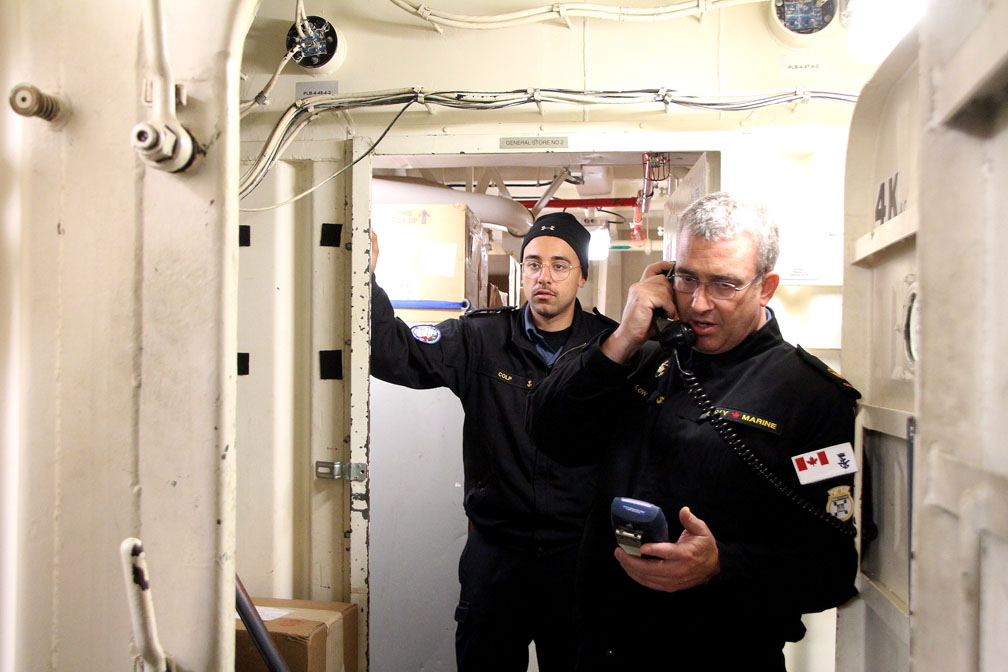Canada’s Navy hones its oil-spill response skills in Arctic waters
HMCS Charlottetown just finished a month-long Arctic deployment in waters in and around Frobisher Bay and Greenland, which included practicing spill responses.

When a crew member signals an alarm after spotting oil spilled aboard HMCS Charlottetown, marine engineer Ronald Low is one of the first people to respond.
With him, he brings a handheld “sniffer” machine that detects flammable vapours and oxygen content, along with gases like hydrogen sulphide and carbon monoxide.
“I proceed with my spill kit bag to the scene,” said Low, who’s a petty officer, first class.
The heavy-duty blue spill bag is filled with soak-up pads for gathering spilled fuel.
But there won’t actually be any fuel for him to soak up this day, Sept. 2, because the spill is staged.
It’s a training scenario aimed at helping sailors figure out what to do should an oil leak ever occur on board.
The Royal Canadian Navy frigate just wrapped up a month-long domestic deployment to northern waters, where the ship and its crew worked in waters in and around Frobisher Bay and sailed to Nuuk, Greenland twice.
In the Arctic, where a ship would have little access to outside support, it’s even more important for the crew to know how to clean up any spills or leaks that could be hazardous to the environment, as well as to crew members.
Low himself didn’t know what the scenario would be like, or where he and his team would have to respond to the spill.
But as soon as a “pipe” came out (that’s what the navy calls an announcement) he knew exactly what part of the ship to head towards.
“The ship is lettered and numbered according to decks and watertight sections,” he said.
This spill was minor, after a pretend leak took place in a pump room used daily to filter helicopter fuel. A fire crew suited up to respond and a med team rallied together, but there was no fire and no casualties in this practice spill.
In case the space becomes dangerous, a cleanup team wears masks and hooded hazard suits.
While preparing to come north, the Charlottetown was outfitted with a pollution boom and crane, along with loads of extra soak-up pads to make sure there are enough tools to respond to a potential spill.
That’s because the sailors know that most communities in the North don’t have the resources to respond to an oil spill, said Lieutenant Johnathen Baldwin, a marine systems engineer and the environmental officer aboard the Charlottetown.
This included the port authority in Nuuk, which doesn’t have a pollution boom for ships to use, Baldwin said.
That boom looks like a big yellow ring that wraps around the exterior of the hull. The ship visited Nuuk twice to refuel.
“We made sure we brought on more soak-up material,” he said.
Prepping for an oil spill wasn’t the only environmental precaution the Charlottetown crew had to consider when sailing in the North.
While the RCN doesn’t fall under the jurisdiction of Transport Canada in regard to environmental regulations, the Canadian Armed Forces does have its own regulations for safety and environmental management, Baldwin said.
On board, all effluent, including food waste and grey water are treated through the ship’s black-water treatment system.
Grey water is water from sinks and showers, while black water is sewage.
“It’s not required [to treat grey water], but it is a policy that has been imposed on the RCN. We try to meet the most stringent regulation out there,” Baldwin said.
“The RCN wants to make sure Arctic waters are used in a lawful manner. We need to set the higher standard right off the bat,” he said.
Grey-water treatment is a concern for environmental groups like the World Wildlife Fund, who say that Transport Canada should be more stringent in how it regulates grey-water treatment and dumping.
Discharge of ballast water, used to level out low fuel tanks and keep the ship stable, is also regulated in the North.
A ship can take Arctic water and discharge it in open oceans, but it’s not OK to take on ballast water from somewhere else and discharge it in the Arctic.
If the navy ship were sailing overseas, crew would be prepared to meet the highest environmental requirements of each nation they visited.
“We choose to adhere to the strictest of regulations,” Baldwin said.
“Every person, right down from the captain to the most junior member, is responsible to make sure they prevent any hazardous occurrences that lead to degradation of the environment.”